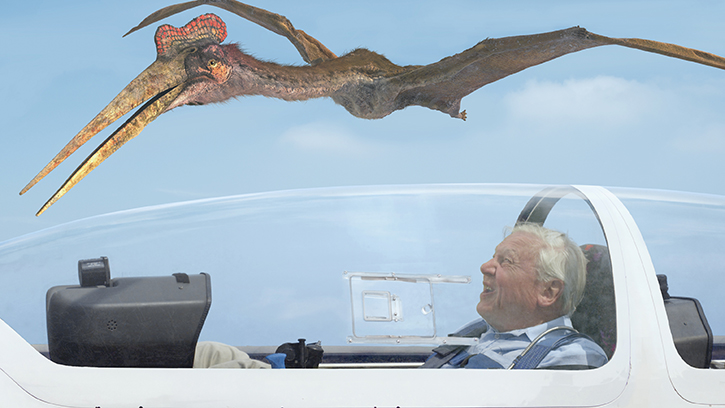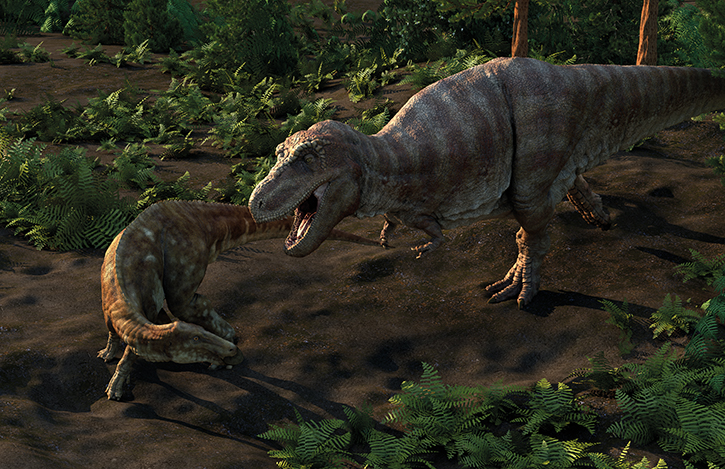A Rex named Sue: How Atlantic Productions brought the Mesozoic to life

Posted on Apr 11, 2019 by Neal Romanek
Atlantic Production is an innovator in natural history documentaries. Its most recent brings the world’s biggest Tyrannosaurus rex to life
“Life finds a way.” That’s the theme of nineties dino resurrection classic, Jurassic Park. Thirty years later, new technologies are being used to bring back the prehistoric past in remarkably realistic ways. At the vanguard of this rebirth is the award-winning Atlantic Productions. No matter what the challenge – 3D, VR, sophisticated visual effects or one-on-ones with the late Stephen Hawking, Barack Obama and regular collaborator Sir David Attenborough – Atlantic finds a way. Along with the BBC Natural History Unit, Atlantic is one of the few documentary producers who could be said to have a world-famous brand. Anthony Geffen started the company in 1992, just as Steven Spielberg started shooting Jurassic Park.
The company’s strategy has been to push the envelope of what is possible in capture, distribution and exhibition technologies to bring factual content – especially natural history content – to new audiences in deeper and richer ways.
“They’re brilliant, these big BBC series, but the danger is they all become very similar,” says Geffen. “You have lions and they’re beautifully filmed and they’re getting better and better. But I think we need to find new narratives.
“When we were working with David Attenborough, we changed the ways he’d worked previously. For example, he never would have done a film like Natural History Museum Alive, where we had amazing animations brought to life in a museum. He was having to act to blank screens. And when we developed Kingdom of Plants 3D, we produced new 3D technology that could reveal new things about plant life. These are methods for seeing the natural world in a different way.”
The company’s willingness to go to any length to find a new story has most recently taken its team to the jungles of Ecuador’s Yasuní National Park, in which the struggles of the documentary crew and the making of the programme are as much a part of the narrative as the creatures they’re documenting.
The production has rigged hundreds of cameras at every level of the rainforest, with the crew working on the forest floor monitoring the action for a whole month. The challenges they face include how to capture footage of a harpy eagle attacking a monkey, which requires rigging multiple light- and action-sensitive cameras in the forest canopy.

Creating the Cretaceous
One thing that sets Atlantic apart from other natural history producers is its in-house CGI team, Zoo VFX. Zoo’s work includes bringing pterosaurs to life in Flying Monsters 3D, recreation of the primordial oceans in First Life and animating the exhibits in the Bafta award-winning Natural History Museum Alive.
“Zoo has an incredible skill base that rivals all the Hollywood studios like ILM or Pixar, but they’re used to working with things that are utterly factual,” says Geffen.
Atlantic has both experience in wildlife documentary and CGI expertise in turning scientific theory into reality. It was this combination that got the attention of the Field Museum in Chicago when it wanted a large-scale animated presentation to accompany the new display of one of the world’s most famous fossils.
Sue is the largest Tyrannosaurus rex skeleton ever found, as well as the most complete. Her new 5100 sq ft gallery opened in December 2018. The gallery features large screens projecting vignettes of Sue’s life, all animated by Zoo in collaboration with palaeontologists – incorporating the latest theories about T. rex anatomy and behaviour.
“It was a year’s process,” explains Emily Smith, Atlantic’s director of business development and museum partnership advisor. “We worked with their palaeontologists to build every detail of these dioramas based on the current scientific understanding of how those creatures would have moved and the environment in which they would have lived. Sue particularly, of course. There’s new research around the gastralia – the bones that help her breathe around the bottom of her belly ribs – and that informed how we then created her in CGI.”
The Atlantic animations are each rear-projected at a custom resolution of 600×2160 pixels onto six large screens, each one measuring 125cm by 270cm, along a 7m gallery. The scenes include Sue’s typical morning – waking up, having a morning drink and a munch on a dead Ankylosaurus, before performing her morning ablutions and walking off into the forest – which is a big hit with children.
In another scene, Sue stalks a herd of Edmontosaurus. In another, there is the classic face-off with a Triceratops. (If you’ve forgotten what a Triceratops looks like, see the cover on issue 11 of FEED.)
The Zoo team also worked with the museum to simulate the gait of an Edmontosaurus, using actual fossil footprints. Utilising the placement of the feet and the length of the stride, the Zoo team and their scientist collaborators used their CGI Edmontosaurus to accurately model what the dinosaur’s real walking would have looked like. It took around 30 run-throughs to get it right.
The animations are accompanied by soundscapes also created by the Zoo team – atmospheres and animal sounds designed to evoke the Cretaceous Period.
“We started off using living creatures that would have been very similar, like a crocodile,” says Smith, “and then doing acoustic modelling to make the voice box much larger, simulating what a T. rex might have sounded like. Again, that was working closely with the palaeontologists.”
“Zoo is very clever at taking things that scientists give them and figuring out how those things could actually work in real life,” says Geffen. “Obviously, we don’t know exactly how dinosaurs did things, but by working through different scenarios, then reworking them with the scientists, the museum gets a new understanding of how dinosaurs lived. They’re not just animators and effects artists, they’re people who can come up with extraordinary things, particularly when it comes to recreating history or animating the ancient animal world.”

Immense immersion
The multiscreen exhibit has been a huge hit. Though Atlantic has been known for its VR and immersive natural history content, in this case, 2D screens in the proper setting have created a dynamic synthesis of CGI content and real-life experience.
“When Emily went to the Field Museum for the launch, it was phenomenal to see so much excitement in the kids and the other people as they were moving through these illuminated panels,” enthuses Geffen.“When you’ve got groups of people and the bones you can see right next to you, that’s a great way of doing it. Virtual reality is good, but that would be another experience of a different kind. I think the museum got it right by going with an experience, which allows you for about 18 minutes to explore it in this way. This narrative, with different screens telling the story, fascinated the youngest to the oldest. The latest technologies might not always be the right way to deliver an experience.”
Smith confirms the excitement that followed the launch: “I witnessed a five year old stay for three rotations of the stories, running backwards and forwards following the T. rex with their finger as it moved around the screens. Yeah, it was quite brilliant to see that audience reaction.” It really shouldn’t be much of a surprise to see children excited by dinosaurs, but it’s not often that documentary producers get to see their audiences physically interacting with the content they create.
Expanding the depth and interactivity of its documentary content is a continuous goal for Atlantic. Part of this strategy is to combine video, data and interactivity in new combinations to engage and educate audiences and provoke wider discussion.
“I think that’s where a whole lot of natural history and documentaries are going to move,” says Geffen. “We’re working on another project now where we’re using artificial intelligence to actually give us a view of how animals see the world. It’s taking on new perspectives. I think we have to go there, using new technologies coming in and since audiences love natural history, but show it in a different way.”

Finding the form
Documentary formats are undergoing changes, too. Geffen sees the possibilities for nature documentary streamed live or broken down into smaller, short-form pieces. Finding these new ways of engaging people becomes especially vital when the global climate is approaching so many cataclysmic environmental tipping points.
One of Atlantic’s recent landmark programmes was a simple face-to-face interview, which looked at the importance of natural history education and the environment. Nothing too groundbreaking about that – except that this was Barack Obama interviewing Sir David Attenborough.
At the other end, during the VR experience Great Barrier Reef with David Attenborough, Atlantic put up an interactive website that allowed millions of people to engage live with the state of the reef. They could monitor the Great Barrier Reef’s health and the robustness of its animal population and the surrounding oceans.
“You could see, during this ocean warming event, a great influx of hot water that was going to hit the Great Barrier Reef,” recalls Geffen. “People said, ‘Well, that’s not really going to hit there. I mean, we can probably stop it.’ And we were sending feeds back saying, ‘No. In two months, it will hit.’ And it did. I think we have to be more clever about how we outreach. We can’t just say a television programme is going solve it.
“When I was working with David, he always had a very good rule, which is to tell the story of something so you fall in love with it. You’re interested by it and you’re curious and it’s only at the end that you start saying, ‘The whole colony of coral on the Great Barrier Reef could be wiped out and could create these problems’. I think, otherwise, people don’t engage.”
From a company that won the first Bafta for VR storytelling, we look forward to ever more engagement and continuing to fall in love with the natural world.
This article originally appeared in the February 2019 issue of FEED magazine.











